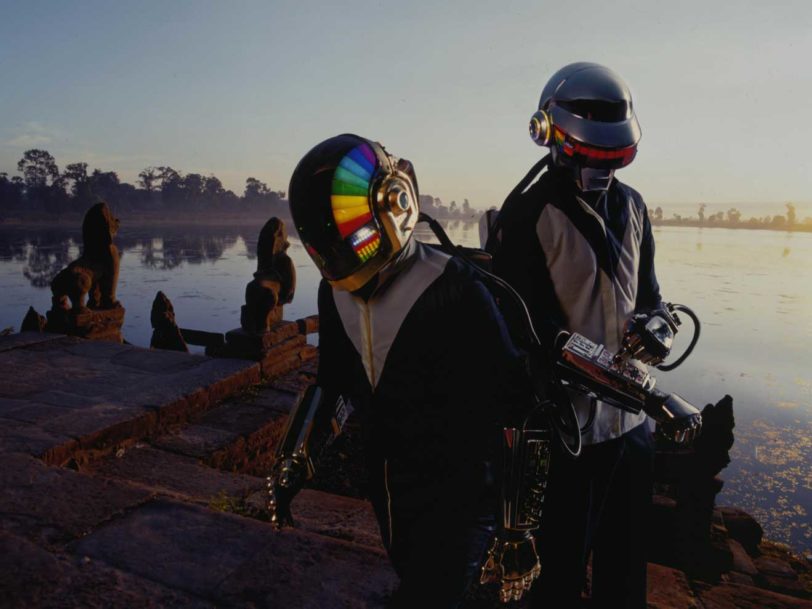When French house duo Thomas Bangalter and Guy-Manuel De Homem-Christo announced they were folding Daft Punk, fans went into mourning. Quite apart from the their pop nous, almost every slice of the group’s output has been a real and tangible part of 21st-century dance music and the multiverse of clubbing that accompanies it. Key to that legacy is the duo’s second album, 2001’s Discovery, which featured the single Digital Love.
Initially an eyebrow-raising departure from the tough, textural mid-90s workouts of their debut album, Homework, Discovery’s fully formed songs were shaped by gleaming production and the group’s irresistible update of 70s and 80s disco and AOR licks. An audible influence on much of the music of the next decade, it even broke out of the dance world and shaped genres such as hip-hop, thanks in no small part to Kanye West, who sampled one of the album’s six singles, Harder, Better, Faster, Stronger for his own 2007 hit, Stronger.
A Balearic blur
The third single from Discovery, Digital Love had some hard acts to follow: it was in competition with the still-anthemic One More Time (featuring vocals from the sadly departed Romanthony) and the spiralling Aerodynamic, but it held the same funky DNA. Lifting a tantalisingly unresolved sample from the intro of George Duke’s 1979 disco tune I Love You More, filtered into a Balearic blur, Daft Punk sprinkled it with some delicate touches from the same Wurlitzer piano the pop-prog outfit Supertramp used on some of their biggest successes. They then topped the song off with vocals whose telephone-like effect recalls Buggles’ smash 1979 hit Video Killed The Radio Star.
On top of this, a careful listen reveals a sort of vocoder effect, possibly produced by the then relatively new Auto-Tune software. A sharply edited break is built from the same George Duke sample, and there’s a guttural, guitar-like synth solo in the song’s closing section, placed over a mean breakbeat. This all resulted in a fresh-faced, creative and summery song which burst out in fine style on 11 June 2001.
An echo of formative years
With lyrics by Chicago house legend DJ Sneak, Digital Love speaks of a fantasy or “dream” relationship. Given the timing, it’s easy to imagine lines such as “That kind of feeling, I’ve waited so long” and “Before I knew it, this dream was all gone” referencing an unfulfilled internet crush. Meanwhile, the song managed to sidestep the usual flurry of tedious remixes common at the time, with just a couple of radio and dub versions coming from the duo themselves, and one functional club edit by German house DJ Boris Dlugosch. From the off, the album version was definitive, though all vinyl editions of the single are now highly collectable.
Quickly asserting itself as one of the best Daft Punk songs of all time, Digital Love went Top 10 in various European countries and further afield, and was also used in a number of adverts and TV shows. Daft Punk themselves even turned up on a GAP advert to perform some goofy dance moves with Juliette Lewis. The song has has racked up many millions of plays in the streaming era, and has itself been sampled numerous times while also inspiring some notable cover versions, including those from Alphabeat, Noah And The Whale and The Royal Concept (underlining Daft Punk’s success in evoking the classic 70s rock sound they were after). Other covers have come from string quartets.
As relevant now as ever
The song’s animated promo video mirrored Sneak’s dream-sequence lyrics and eventually formed part of the group’s full-length animated sci-fi movie companion to Discovery, Interstella 5555: The 5tory Of The 5ecret 5tar 5ystem, which recalled the earliest Japanese anime to reach the West – in the form of planet-hopping children’s TV sagas – in much the same way as the Discovery album itself echoed the music of the duo’s formative years.
Perhaps above all, Digital Love pointed Daft Punk towards the sound they would mine so profitably a decade or so later on their final studio album, 2013’s Random Access Memories, with songs such as Get Lucky and Give Life Back To Music. Yet the best pop music shapes itself to each generation’s experiences. In a post-pandemic world, listeners can all relate to loving someone from distance, their presence experienced only through technology and dream. “In this dream, I’m dancing right beside you/And it looked like everyone was having fun” has never sounded so prescient.
Whether you are part of the reeling dance-music community, or just stuck at home wishing you could hug your nearest and dearest, Digital Love is as relevant now as ever.
Find out where Digital Love ranks on our best Daft Punk songs.
More Like This
Vogue: The Story Behind Madonna’s Most Celebrated Video
As iconic as it gets, the promo video for Madonna’s Vogue single proved that the “Queen Of Pop” was all about making high art.
What’s Love Got To Do With It: Behind Tina Turner’s Universally Adored Anthem
A true 80s mega-hit, What’s Love Got To Do With It defined Tina Turner’s career, if not her outlook on life…
Be the first to know
Stay up-to-date with the latest music news, new releases, special offers and other discounts!




